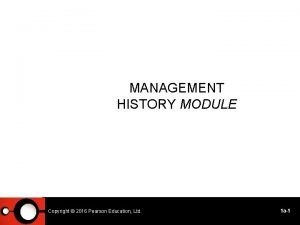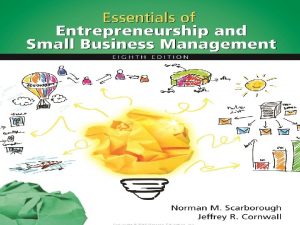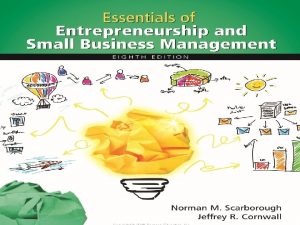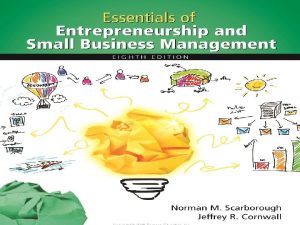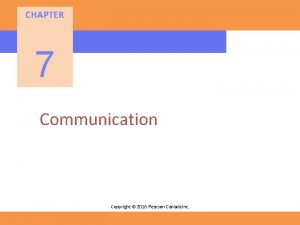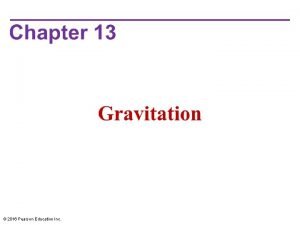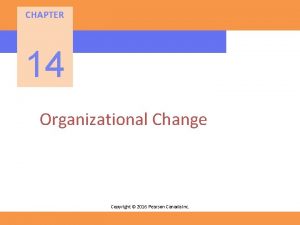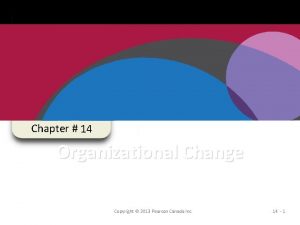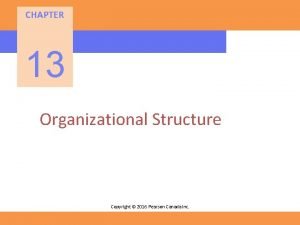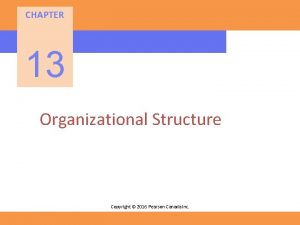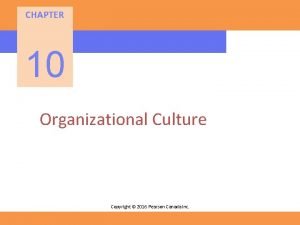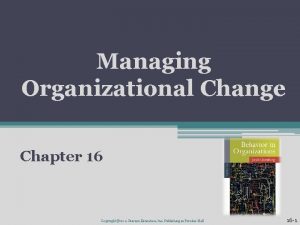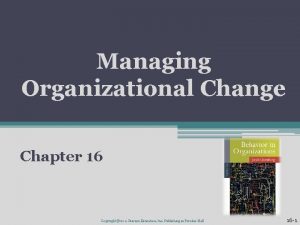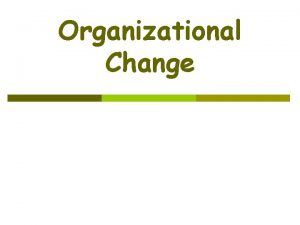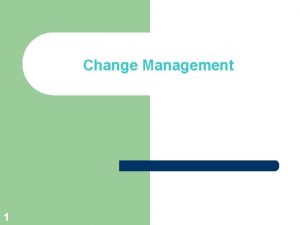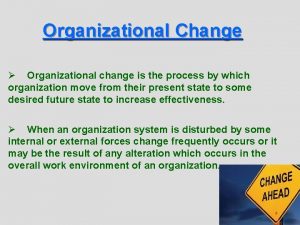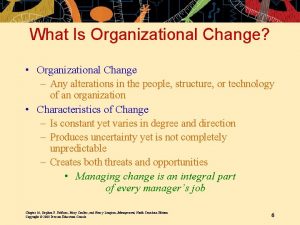CHAPTER 14 Organizational Change Copyright 2016 Pearson Canada























- Slides: 23

CHAPTER 14 Organizational Change Copyright © 2016 Pearson Canada Inc.

Forces for Change Nature of the workforce Technology Economic shocks Competition Social Trends World politics

Organizational Targets for Change • • Purpose Technology Structure Tasks People Culture Strategy Objective Copyright © 2016 Pearson Canada Inc.

Change Agents • People who act as catalysts and assume the responsibility for managing change activities. – Managers or non managers – Employees of the organization – Outside consultants Copyright © 2016 Pearson Canada Inc.

Resistance to Change • Resistance to change can be positive if it leads to open discussion and debate. • Resistance to change does not necessarily surface in standardized ways. • It can be: – Overt – Implicit – Immediate – Deferred Copyright © 2016 Pearson Canada Inc.

Exhibit 14 -7 Sources of Individual Resistance to Change Copyright © 2016 Pearson Canada Inc.

Cynicism About Change • Feeling uninformed about what was happening. • Lack of communication and respect from one’s supervisor. • Lack of communication and respect from one’s union representative. • Lack of opportunity for meaningful participation in decision-making. Copyright © 2016 Pearson Canada Inc.

Six Major Sources of Organizational Resistance Ø Structural inertia Ø Limited focus of change Ø Group inertia Ø Threat to expertise Ø Threat to established power relationships Ø Threat to established resource allocations

Overcoming Resistance to Change • Education and communication – This tactic assumes that the source of resistance lies in misinformation or poor communication. – Best used: Lack of information, or inaccurate information • Participation and involvement – Prior to making a change, those opposed can be brought into the decision process. – Best used: Where initiators lack information, and others have power to resist • Building support and commitment – Employee counselling and therapy, new-skills training, or a short paid leave of absence may facilitate adjustment. – Best used: To help employees emotionally commit to the change Copyright © 2016 Pearson Canada Inc.

Overcoming Resistance to Change • Developing positive relationships – Establish trust in the managers implementing the change. – Best used: When one has a more positive relationship with supervisors and who felt that the work environment supported development • Implementing changes fairly – Make sure the change is implemented fairly. – Best used: When employees perceive an outcome as negative, so its crucial that employees see the reason for the change and perceive its implementation as fair. Copyright © 2016 Pearson Canada Inc.

Overcoming Resistance to Change • Manipulation and co-optation – Twisting and distorting facts to make them appear more attractive. – Best used: Where other tactics won’t work or are too expensive • Selecting people who accept the change – Open to the experience and take a positive attitude toward change. – Best used: when selecting people predisposed to accept change to facilitate the change. • Explicit and implicit coercion – The application of direct threats or force upon resisters. – Best used: Speed is essential, and initiators have power Copyright © 2016 Pearson Canada Inc.

Politics of Change • The demand for change is more likely to come from: – outside change agents – employees who are new to the organization – managers who are slightly removed from the main power structure • Employees who have spent their entire career with the organization are often major impediments to change. Copyright © 2016 Pearson Canada Inc.

Creating a Culture for Change • Organizations embrace change by transforming their cultures through two approaches: – Stimulating a Culture of Innovation – Creating a Learning Organization Copyright © 2016 Pearson Canada Inc.

Stimulating a Culture of Innovation • Innovation – A new idea applied to initiating or improving a product, process, or service. • Sources of Innovation – Structural variables – Cultures – Human resources Copyright © 2016 Pearson Canada Inc.

Stimulating a Culture of Innovation • Structural Variables – – Organic structures positively influence innovation Long tenure in management is associated with innovation Innovation is nurtured when there are slack resources Interunit communication is high in innovative organizations • Cultures – Encourage experimentation – Reward both successes and failures – Celebrate mistakes Copyright © 2016 Pearson Canada Inc.

Stimulating a Culture of Innovation • Human resources: – Actively promote the training and development of their members – Offer high job security – Encourage individuals to become idea champions – Champions have common personality characteristics: high self-confidence, persistence, energy, and a tendency to take risks Copyright © 2016 Pearson Canada Inc.

Creating a Learning Organization • Learning Organization: An organization that has developed the continuous capacity to adapt and change. – Single-loop learning • Errors are corrected using past routines and present policies. – Double-loop learning • Errors are corrected by modifying the organization’s objectives, policies, and standard routines. Copyright © 2016 Pearson Canada Inc.

Creating a Learning Organization • Three fundamental problems of traditional organizations: 1. Fragmentation • Based on specialization creates “walls” and “chimneys” that separate different functions into independent and often warring fiefdoms 2. Competition • An overemphasis on competition often undermines collaboration. 3. Reactiveness • Misdirects management’s attention to problem solving rather than creation. Copyright © 2016 Pearson Canada Inc.

Exhibit 14 -9 Characteristics of a Learning Organization Copyright © 2016 Pearson Canada Inc.

Summary 1. Individuals resist change; breaking down that resistance is important. 2. Change requires unfreezing the status quo, moving to a new state, and making the new change permanent. 3. Innovative cultures reward both successes and failures so that people are not afraid to make mistakes. Copyright © 2016 Pearson Canada Inc.

OB at Work: For Review 1. What are the forces for change? 2. What are the four main approaches to managing organizational change? 3. What forces act as sources of resistance to change? 4. How can managers create a culture for change? Copyright © 2016 Pearson Canada Inc.

OB at Work: For Managers ■ Consider that, as a manager, you are a change agent in your organization. The decisions you make and your role-modelling behaviour will help shape the organization’s change culture. ■ Your management policies and practices will determine the degree to which the organization learns and adapts to changing environmental factors. Copyright © 2016 Pearson Canada Inc.

OB at Work: For Managers ■ People resist change because change can be stressful. Low to moderate amounts of stress enable many people to perform their jobs better by increasing their work intensity, alertness, and ability to react. Therefore, don’t hesitate to introduce change just because stress might be induced. Copyright © 2016 Pearson Canada Inc.
 Pearson education inc 4
Pearson education inc 4 2016 pearson education inc
2016 pearson education inc 2016 pearson education inc
2016 pearson education inc 2016 pearson education inc
2016 pearson education inc 2016 pearson education inc
2016 pearson education inc 2016 pearson education inc
2016 pearson education inc 2016 pearson education inc
2016 pearson education inc 2016 pearson education inc
2016 pearson education inc 2016 pearson education inc
2016 pearson education inc 2016 pearson education inc
2016 pearson education inc 2016 pearson education inc
2016 pearson education inc 2016 pearson education inc
2016 pearson education inc 2016 pearson education inc
2016 pearson education inc 2016 pearson education inc
2016 pearson education inc Pearson education limited 2017
Pearson education limited 2017 Copyright by pearson education inc. answers
Copyright by pearson education inc. answers Copyright 2010 pearson education inc
Copyright 2010 pearson education inc Copyright 2009 pearson education inc
Copyright 2009 pearson education inc Copyright pearson education inc
Copyright pearson education inc 2014 pearson education inc
2014 pearson education inc Copyright 2010 pearson education inc
Copyright 2010 pearson education inc Copyright 2010 pearson education inc
Copyright 2010 pearson education inc Copyright by pearson education inc. answers
Copyright by pearson education inc. answers 2008 pearson education inc
2008 pearson education inc


